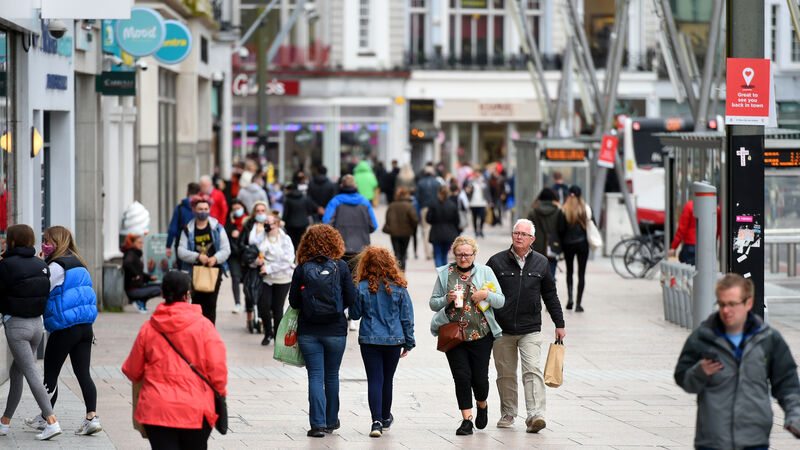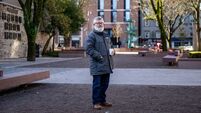Michael Moynihan: Cities don’t have a guarantee of survival

Busy streets.....Sunday 23rd May2021.
If you are old enough — and your columnist certainly qualifies under this heading — then you’ll remember Cork 800.
This was a year-long festival held in 1985 to commemorate the 800th anniversary of the city receiving a royal charter from Prince John, one which stays with me for two main reasons.
It began with an air show that had to be cancelled because of cloud cover at Cork Airport, but hundreds still turned up for the day (it was 1985 and entertainment was thin on the ground. What can I tell you?).
The other element from the year which stays with me was the commemorative milk bottle (again, it was 1985, etc).
But the fact that Cork had been recognised as a city for eight centuries did resonate, and still does. Anything which lasts that long has to be admired, because not everything makes it through eight centuries.
That includes cities.
I don’t want anyone getting nervous over their breakfast, but cities don’t have a guarantee of survival. Some of the biggest cities at various periods of history no longer exist.
With a view to getting an idea why, and perhaps working out what Cork should do to ensure its survival I had a chat with Annalee Newitz, whose book Four Lost Cities: A Secret History of the Urban Age describes Çatalhöyük, Cahokia, Angkor and Pompeii, four major cities which are now lost, as the title puts it (when I say major, I mean it — 1,000 years ago Cahokia, in the US midwest, was bigger than Paris at that time).
Newitz opened with a declaration of faith: “I love cities, it’s as simple as that. Like a lot of writers I also think I’m intrigued by things that destroy what I love, so while I’m interested in what makes people want to live in cities, the cities I dealt with in my book were abandoned by people.
“And those were great cities, so my question was simple — what leads to that, what’s the moment when people decide to move away from a city, despite how difficult and uncertain that move is?
“A lot of us are experiencing a lot of anxiety about the future of our cities here in America, and whether they can survive because of different issues — issues of climate change, issues of political uncertainty.
“So there was a swirling mass of reasons for taking the book on, but as I say, I really love cities and wanted to spend more time thinking about them and their future.”
What intrigued me was how Newitz sees the challenge to cities coming on two particular fronts, and how those two fronts — environmental challenges and political stability — can make for a dangerous combination.
“From the examples I looked at, it seems that cities are pretty resilient unless you have a combination of some kind of environmental challenge, like a drought or a flood, and if that combines with political instability, that can drive people away from the city. That’s one of the big themes in the book.
“With all of the examples I looked at for the book — except for Pompeii, which was of course buried under hot ash — these abandonments take time, and can be reversible.
There can be a hundred years of people living a city, but the tide can turn, and the process can go into reverse, with the city becoming revived and rejuvenated.
“In a city that’s very hard to see happening — it’s rare to be able to see it in one lifetime, even, because it tends to happen generationally.
“In that sense it’s a cause for hope for many of us, that the process can reverse itself, but the other side is that you can be living in a city that’s slowly dying without you knowing it.”
This is an interesting point with an immediate relevance to our own situation. Take the number of derelict buildings in Cork. Is this a temporary problem or a fatal symptom? Given the timeframes involved, how slowly a city changes, how can we really tell unless we can leap forward half a millennium?
Newitz points out, incidentally, that dereliction is also a part of city life.
“Something archaeologists at Çatalhöyük complained about was that when people drew representations of the city, it was always shown with every single one of the buildings of the city in full repair, all the houses glowing with cleanliness. The archaeologists complain because they say half the buildings in the city would have been falling apart and full of poop — when a house fell over the neighbours would turn it into a trash pit for a while before eventually building on top of it.
“In the US there were popular public programmes in the eighties and nineties which suggested that if you kept the city spick and span that that would prevent crime — if people didn’t see broken windows they wouldn’t commit crimes, hence the famous ‘broken windows’ theory.
“The jury is still out on that because while we don’t like to see broken windows in buildings, it’s not nice to look at, but whether that helps to improve people’s lives than — for instance — better healthcare or robust social welfare programmes, well, I’m not sure.
I think I’d prefer social welfare programmes to a fixed-up house at the end of the block, though in an ideal world you could have both.
When we spoke Newitz said there was a good deal of nervousness in California about what the summer heat would do to cities there. For Cork the environmental challenge is more water-based, but that still creates real anxiety.
“If we’re interested in having our cities last a long time, then we need to think about how to invest in infrastructure in the city which keeps it robust in the face of environmental challenges,” said Newitz.
“Also, how do we invest in a political system that takes care of people who are both poor and rich? With some of the cities I looked at, the political systems aren’t the same as ours, but something you can look at is how the city’s rulers treated the people who dug ditches in those cities.
“And if they treat those people badly instead of giving them food, housing, basic rights — then that’s part of the instability I mentioned, the mistreatment of labour.
“I think the long arc of history suggests that often when a city is falling apart, then the people living there rally around to rejuvenate it. We’ve seen that happen, which is hopeful, but we’ve also seen that it’s important to hold our municipal governments accountable and to make sure they’re making the right decisions for us.”
Her parting shot, however, casts cities in a completely different light.
“I’m hopeful about humanity’s ability to repair cities and to come up with better political systems which can keep people in cities healthy and safe. Some cities are not built to last — just because a city lasts for a long time that doesn’t mean it’s successful.”
An interesting thought, because longevity in a town or city suggests significance. Should we re-evaluate any plans for a Cork 1600, or just drop the mic and walk off the stage right now?
I think you know the answer.
CONNECT WITH US TODAY
Be the first to know the latest news and updates











